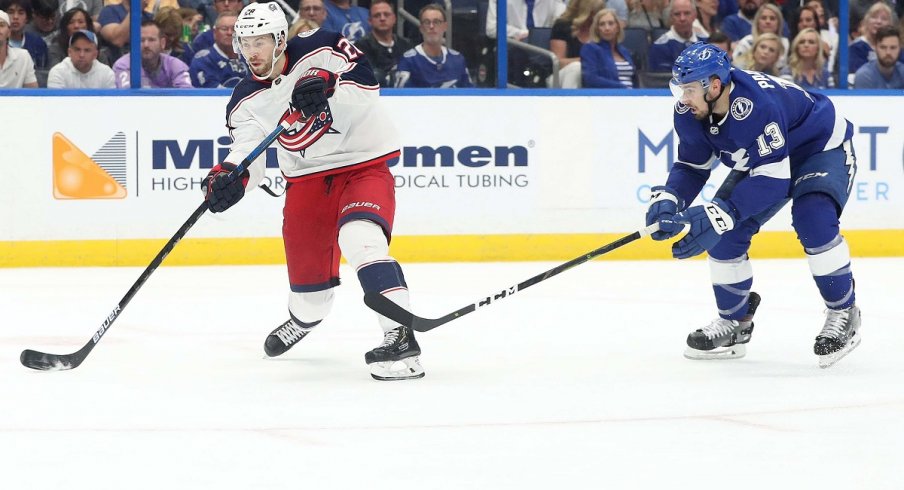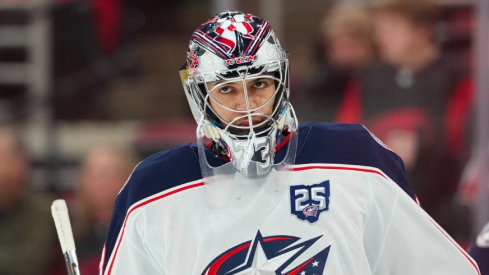Oliver Bjorkstrand knows how to score a big goal.
His reputation as a sniper was forged with the Portland Winterhawks of the WHL, the same junior club that produced the likes of Seth Jones and Brandon Dubinsky. After his illustrious junior career ended, Bjorkstrand joined the (then) Lake Erie Monsters. In his first AHL season, the Monsters won a Calder Cup championship in large part due to Bjorkstrand's 10 playoff goals in 17 games. His six post-season game-winning goals tied an AHL record. He even scored the Calder Cup-winning goal.
Fast forward to 2019 and Oliver Bjorkstrand has already left an indelible mark in Blue Jackets' lore, scoring the game-winning goal in Game 3, and adding the series-clinching goal in Game 4, both coming at Nationwide Arena.
His Game 3 goal was vintage Bjorkstrand. On the power play, Alexandre Texier entered the zone with possession, drew a defender to him, and dropped the puck back to Seth Jones. Jones faked a slap shot and found Bjorkstrand on the weak side. The sniper didn't miss from there.
OLIVER BJORKSTRAND DOUBLES THE COLUMBUS LEAD!#CBJ 2 - 0 #GoBolts
— Hockey Daily #StickTogether (@HockeyDaily365) April 15, 2019
(Columbus Leads Series 2-0) pic.twitter.com/0pb90sfl63
In Game 4, Bjorkstrand scored arguably the biggest goal of his career. On a delayed penalty (that he drew), the winger lurked behind the play, waiting for a moment to strike. When Dubois slid the puck to a dangerous area, Andrei Vasilevskiy was unable to cover the puck. That's when Bjorkstrand appeared at the back post, knocking a loose puck into a gaping net.
OLIVER BJORKSTRAND SLAMS HOME THE REBOUND! COLUMBUS RETAKES THE LEAD!#CBJ 4 - 3 #GoBolts
— Hockey Daily #StickTogether (@HockeyDaily365) April 17, 2019
(CBJ Leads Series 3-0) pic.twitter.com/yrcCxhkVec
Consider that, prior to the Game 3 win, the Blue Jackets were a mere 2-8 at Nationwide Arena in the playoffs. Bjorkstrand has game-winners in two consecutive home games and was one of seven players on the Blue Jackets to score at a point-per-game pace, joining Matt Duchene, Cam Atkinson, Panarin, Dubois, Jones, and Zach Werenski.
But Bjorkstrand's contributions go beyond that. Playing alongside Artemi Panarin and Pierre-Luc Dubois on the Blue Jackets' top line, Bjorkstrand showed a level of tenacity in his forecheck that we've not seen before. It isn't a coincidence that on both Texier's power play goal and Bjorkstrand's game-winner, he drew the penalty that gave the Blue Jackets the man advantage.
Ironically, Bjorkstrand's average time on ice (TOI) has diminished in each season he's been in the NHL. In his rookie season, he averaged 15:59 over 12 games. That dropped to 14:05 and 14:18 in his next two seasons. And this year, he averaged just 12:20 through 77 games, despite scoring a career-best 23 goals. This website advocated for a bump in ice time for the dangerous winger, and finally, that happened. In the four-game sweep over the Lightning, Bjorkstrand tallied two goals and two assists with an average workload of 16:17, including a career post-season high of 17:52 in the Game 4 win.
His contributions are confirmed by puck possession data, too. In the sweep, no other Blue Jackets forward had a higher 5-on-5 scoring chances for % (60.47%) or high-danger scoring chances for % (72.22%) than Bjorkstrand.
Bjorkstrand has found success playing alongside Dubois and Panarin. Regardless of the opponent in the next round, John Tortorella should continue to lean on his sniper to help tilt the ice in his team's favor. It would be too simplistic to suggest that Bjorkstrand is the reason the Blue Jackets handled the Tampa Bay Lightning, but his contributions were significant, and it would be wise to continue to give meaningful minutes the Danish dynamo.


